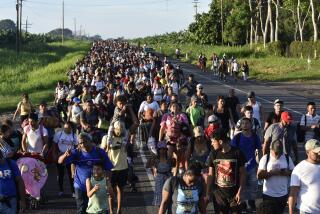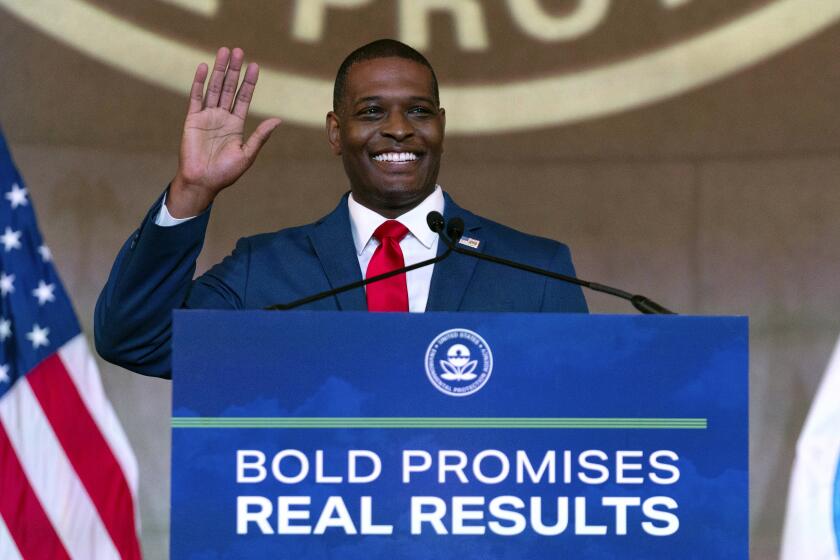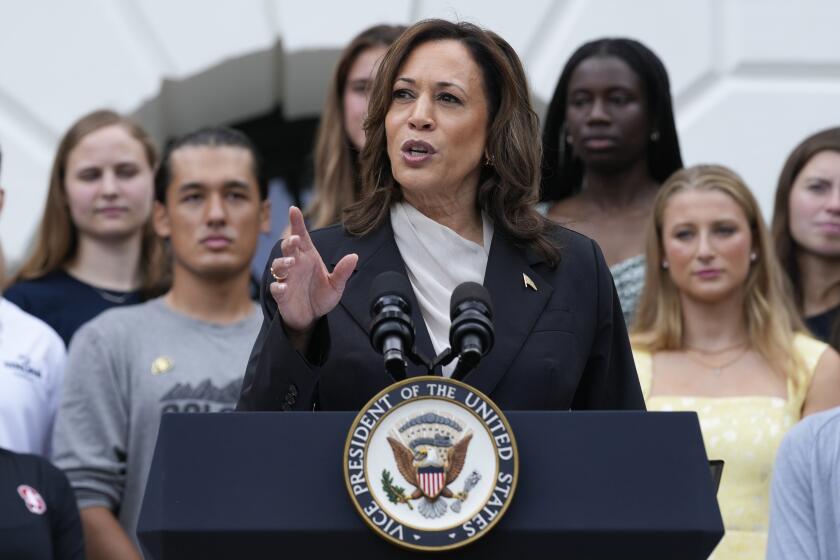Iraq Test-Fires Battlefield Missiles, Officials Say : Military: The exercise occurs within nation’s borders. 15 Americans go free. Baghdad warns against Soviet role.
Iraqi President Saddam Hussein’s land forces on Sunday test-fired battlefield missiles on Iraqi territory, American and British officials said.
“The firing appeared to be part of a test or training mission,” a spokesman for the U.S. General Information Bureau told reporters in Saudi Arabia.
In London, a British Defense Ministry spokesman confirmed the report. “We are aware of missile activity within Iraq earlier today, and necessary precautions were taken by British forces.”
In the United States, Defense Secretary Dick Cheney confirmed that Iraqi President Saddam Hussein “has test-fired some Scud missiles . . . or Scud variants, fired them within Iraq.”
In other developments in the Persian Gulf crisis, Muhammad Ali, the former heavyweight boxing champion, arrived in Amman with 15 American hostages released by President Hussein. And the Iraqi Foreign Ministry asserted that the Soviet Union might use the issue of its citizens trapped in Iraq as justification to send military forces to the Persian Gulf region.
The Iraqi missile firings “appeared to be part of a test or training mission,” the American spokesman in Saudi Arabia said. “The flight path of the missiles was away from U.S. and coalition forces.”
Cheney, in an interview with ABC’s “This Week With David Brinkley,” said that the missiles “were launched inside Iraq and landed inside Iraq in a test program.” He said it was the first such Iraqi test since last April.
“It’s, I think, proof again, if anybody needed it, that he does indeed have ballistic missiles,” Cheney said.
In reply to questions, Cheney said that the Soviet-made Scud “could conceivably carry chemical weapons, but in the past he (Hussein) has used them with conventional high explosives.”
He added that the missiles have a range of 360-400 miles and are accurate enough to hit a city but not a pinpoint target. He did not disclose the number of missiles tested.
Neither the American nor British officials divulged the source of their reports, but military activity in Iraq is monitored by U.S. satellites and AWACs radar planes.
The Iraqi charge that Moscow might be seeking justification for deploying forces in the region came in a report of the official Iraqi News Agency. It quoted a Foreign Ministry official as citing a comment by Soviet Foreign Minister Eduard A. Shevardnadze that Moscow’s troops would be committed for the first time if the estimated 3,000 Soviet civilian workers in Iraq are mistreated. More than 9,000 Soviets, primarily technicians, were working in Iraq at the time of the invasion of Kuwait four months ago.
The unidentified Baghdad spokesman called Shevardnadze’s remark “hostile” and declared: “The Soviet leadership will lose much of its friendship’s credibility with 200 million Arabs if the Soviet activity goes further than it has gone so far.”
Moscow has supported the series of U.N. Security Council resolutions aimed at forcing Iraqi troops out of Kuwait. Three Soviet naval vessels are operating in or near Persian Gulf waters but have not taken part in coordinated operations with Western warships.
In an interview with the official news agency Tass after last week’s Security Council vote authorizing military action against Iraq if its forces are not withdrawn by Jan. 15, the Soviet foreign minister declared, “It’s high time to end inaction in situations when human life, dignity and fate become expendable currency in an immoral political game.
“We will take all necessary steps in this case (if Soviet lives are threatened in Iraq),” he told the Tass reporter. “Everyone should know that we will not hesitate to use force to protect our citizens.”
Before the Aug. 2 invasion of Kuwait, Moscow had been Baghdad’s primary weapons supplier.
While the Soviets in Iraq have not been officially detained, many of the Americans who flew out of Baghdad on Sunday with Ali and his party had been held at strategic sites as “human shields” against possible attack, an Ali spokesman said. About 100 Americans are still held at the sites, according to U.S. estimates, along with several hundred more who have taken shelter in U.S. diplomatic compounds in Baghdad.
Also aboard the Iraqi Airways flight when it landed here were two Canadians, six Britons and 10 other unidentified Westerners, airport officials told reporters.
Arthur Morrison, a Florida public relations man who accompanied the former boxing champion to Iraq, identified the released Americans as:
George Charchalis of Reno; Ralph Leidholdt of Lakewood, Colo.; Richard Iliff of Roswell, Ga.; Harold Martin of Tulsa, Okla.; Dean Shannon of Cuero, Tex.; Bobby Means of Belle Chasse, La.; R.L. Smart of Liberty, Tex.; Desmond Bailey of Crosby, Tex.; Bobby R. Anderson of Round Rock, Tex.; Harry Brill-Edwards of Ft. Lee, N.J.; Sergio Coletta of Moss Point, Miss., and Ken Beasley, Marlin Gillmore, Julio Loyala and Bill McHann, all of Texas.
More to Read
Sign up for Essential California
The most important California stories and recommendations in your inbox every morning.
You may occasionally receive promotional content from the Los Angeles Times.






